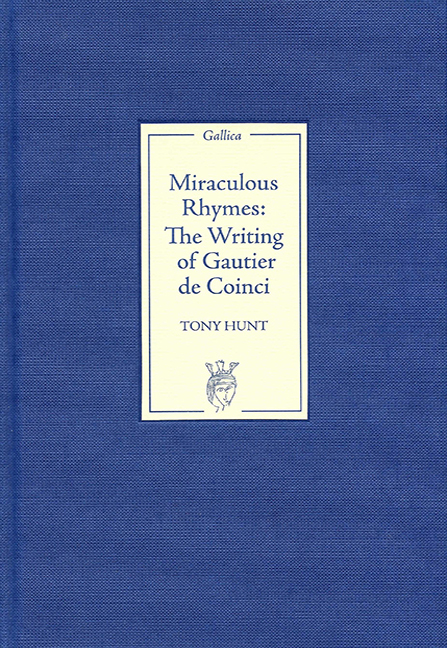2 - Bookends
from Part I - The Writer and his Writing
Published online by Cambridge University Press: 29 April 2017
Summary
Our study of the compositional features of the Miracles de Nostre Dame has shown the strong connection between structures and wordplay, the latter appearing as anything but incidental decoration. Aside from the miracle narratives themselves, however, Gautier includes in the ‘grant livre’ a number of major prologues and epilogues in the manner of a frame, or ‘bookends’, which now deserve examination if we are to come to a proper understanding of his purpose and the means he adopted for achieving it. It will emerge that his aim is to appropriate the language, themes and characters of courtly literature with the intention of transcending that world in a vision of Mariocentric love to which his audience will find themselves subtly transported. The First Prologue of Book 1 (1 Pr 1) at once confirms the lexical and rhetorical exuberance with which he customarily invests his writing and which differentiates it from that of the jongleurs. The conscious artistry of this writing is already apparent in the multiple hendiadys, that is, the binomial constructions used to designate glory, recollection, Our Lady, and the poet, with which he begins:
A la loenge et a la gloire
En ramembrance et en memoire
De la roïne et de la dame
Cui je commant mon cors et m'ame.
(1–4)
The poet's subservience to Our Lady, hands clasped (‘a jointes mains’, 5), an ubiquitous emblematic gesture in the Miracles, plays on both religious and feudal connotations. His purpose is to translate into verse (‘translater ... en rime et metre’) the miracles he has found in a Latin source in the library at Saint-Médard, primarily for the sake of those, both male and female, who have no Latin (‘la letre / n'entendent pas’, 8–9) and who may find a useful illustration (‘boen essample’, 18) in the miracles he reports, just as he himself finds unalloyed pleasure (delit) in narrating material concerning Our Lady,
Qu'el reciter ai grant delit;
Sovent m'i vois mout delitant.
Escriture dist de li tant
Que chascons se doit deliter
En quanqu'est de li reciter.
(26–30)
- Type
- Chapter
- Information
- Miraculous RhymesThe Writing of Gautier de Coinci, pp. 49 - 72Publisher: Boydell & BrewerPrint publication year: 2007



